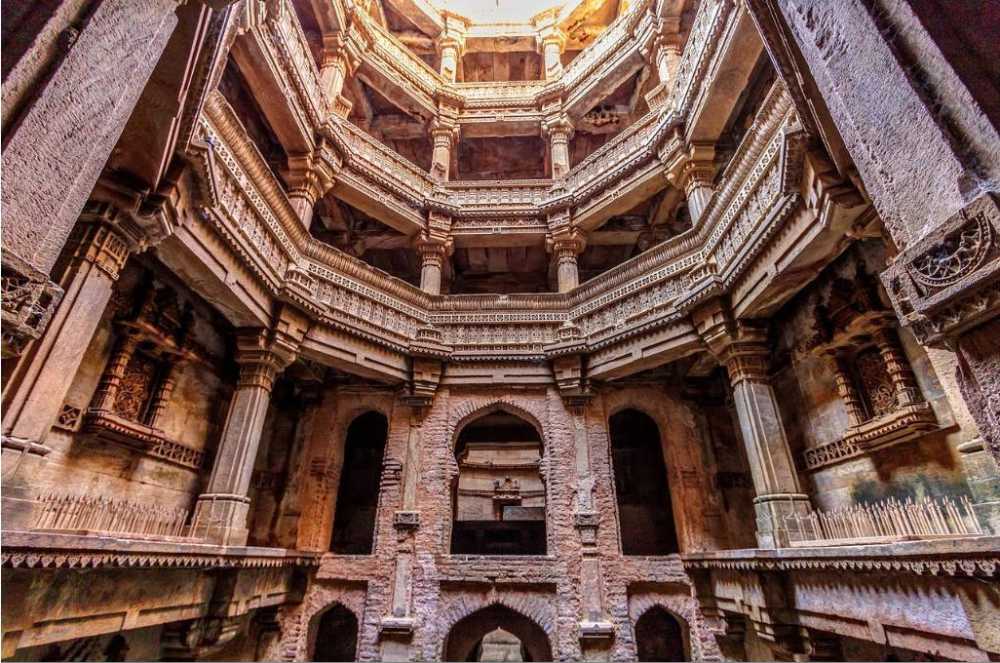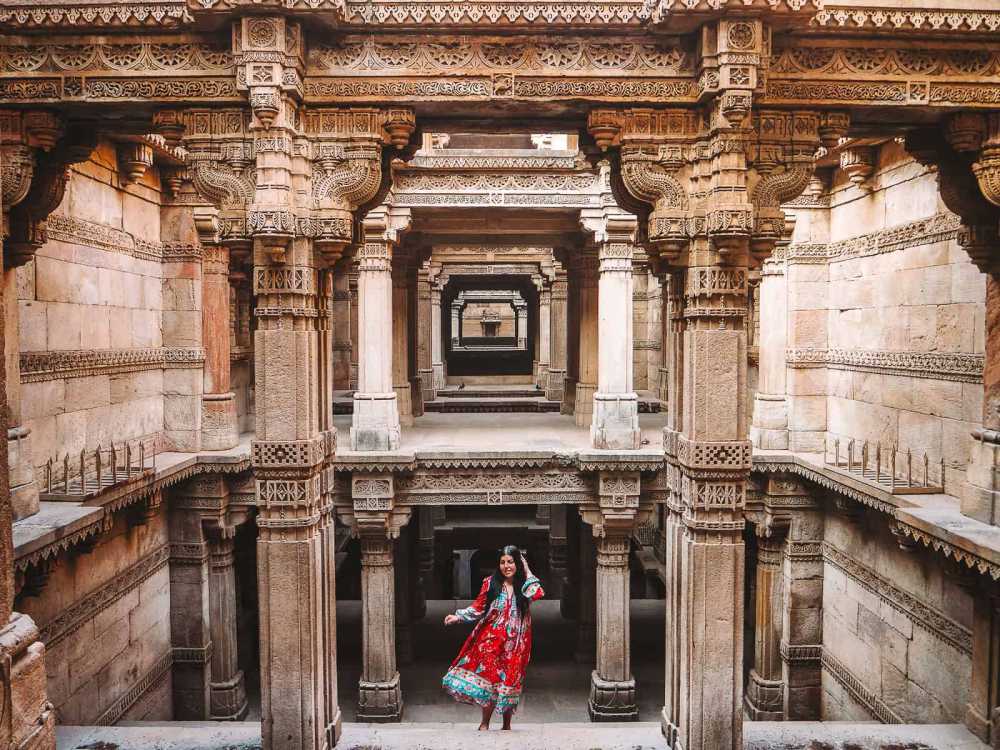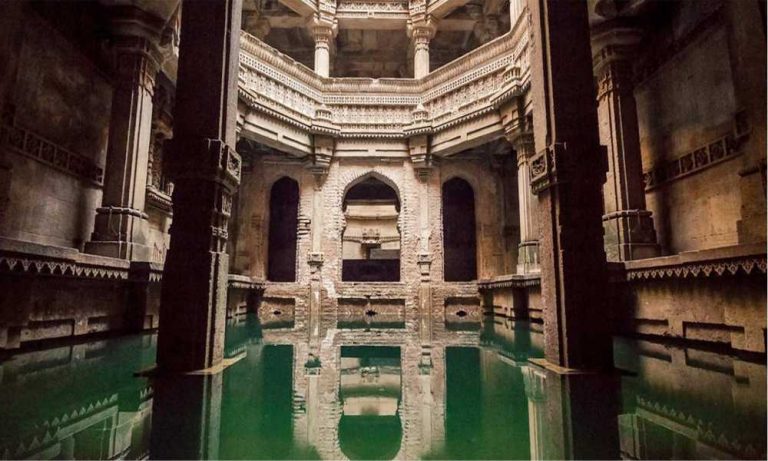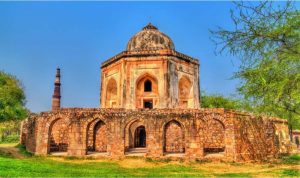Hidden in the calm village of Adalaj, near Ahmedabad in Gujarat, lies one of India’s finest stepwells — the Adalaj Stepwell, also known locally as Adalaj ni Vav. It is not just a source of water but a story of love, loss, and royal devotion. Every carved wall and stone pillar tells a tale that has survived for over five centuries.
History of Adalaj Stepwell
The Adalaj Stepwell was built in 1499 AD by Queen Rudabai, wife of Rana Veer Singh, the ruler of Vaghela dynasty. At that time this place was known as Dandai Desh.
The story goes that the kingdom was facing a long drought. Water was scarce and people were suffering a lot. To solve this problem Rana Veer Singh decided to build a stepwell – not just a water source but also a place where travelers and villagers could rest during the hot summer months.
Unfortunately, the king died in battle before the work was completed. His unfinished dream caught the attention of Sultan Mahmud Begada of Gujarat who was impressed by Queen Rudabai’s beauty and wisdom. He offered to complete the construction if she would marry him.
The queen agreed on one condition – that he must complete the stepwell exactly as planned by her late husband. When the last stone was placed Queen Rudabai looked at the beautiful monument, prayed for her husband’s soul and jumped into the water.
This is the tragic story that gives the Adalaj Stepwell its emotional depth. Today it stands not only as an example of great craftsmanship but also as a symbol of eternal love and sacrifice.
Architecture of Adalaj Stepwell

The Adalaj Stepwell is a remarkable example of Indian architectural brilliance. It was built using sandstone, designed in the Solanki style, and shows the blend of Hindu, Jain, and Islamic art — something rare for that period. The stepwell goes five stories deep, with a series of platforms, corridors, and intricately carved pillars. Each level has beautifully detailed stonework — floral patterns, mythological scenes, and geometric designs.
One of the most fascinating features of the stepwell is its temperature balance. Even on the hottest days, the air inside stays cool and pleasant. This was achieved through clever design that allows air to circulate naturally. The carvings also carry symbolic meanings. On the walls, you can see images of gods, dancers, and everyday village life. The blend of different cultural styles shows how art in that era went beyond religion — it celebrated creativity itself. Also, don’t miss visiting Gujarat Culture Tourism.
The Mystery and Legend of Adalaj Stepwell
Every ancient site has a few secrets, and the Adalaj Stepwell is no exception. Locals believe Queen Rudabai still haunts the place. Some visitors say they feel a strange calmness or a sudden chill. Others believe the quiet corners of the stepwell hold the memories of the queen’s last moments. Whether its true or not, it adds to the mystique.
Today people visit not out of fear but to see the beauty and feel the silence in the air. The story of love and loss makes the Adalaj Stepwell horror story more of a timeless romance than a horror story.
Adalaj Stepwell Timing, Ticket Price, and Location

If you plan to visit, here’s the practical information you’ll need:
Adalaj Stepwell Timing:
The site is open every day from 6:00 AM to 6:00 PM. Early morning and late afternoon are the best times to visit when the sunlight creates beautiful shadows inside the structure. After this, don’t miss a visit to the scenic Kankaria lake Ahmedabad.
Adalaj Stepwell Ticket Price:
Entry is free for all visitors. You might need to pay a small parking fee if you come by car.
How to Reach:
The stepwell is located about 18 km from Ahmedabad city center. You can take a cab, bus, or metro.
Adalaj Stepwell Nearest Metro Station:
The nearest station is Motera Stadium Station. From there, you can easily reach by auto-rickshaw or taxi.
What Makes Adalaj Stepwell Special
The Adalaj Stepwell is more than a historic monument. It is an architectural wonder, a cool resting place, and a symbol of devotion. When you walk down the steps, you move from light into shade, from noise into silence.
The temperature drops as you go deeper, and the play of sunlight through carved arches makes the place glow. You can almost imagine how traders, pilgrims, and villagers once gathered here to rest and share stories.
Even today, visitors spend hours admiring the carvings, clicking photographs, or simply sitting quietly to enjoy the peace that fills the air. For a smooth and enjoyable trip, check out these essential travel tips for Gujarat.
Nearby Attractions:
| S.No | Nearby Attraction | Timing / Day | Charges for Entry | Distance Trivia |
| 1 | Hathee Singh Jain Temple | 8 am to 5 pm, All Day | Free | 20km, 30minutes |
| 2 | Sabarmati Riverfront | 9 am to 9 pm, All Day | Free | 22km, 31 minutes |
Interesting Facts About Adalaj Stepwell
- The stepwell is around 75 feet deep and goes down five levels.
- It took several years to complete and was built entirely with sandstone.
- The walls show carvings of elephants, dancers, and flowers.
- The site reflects three architectural styles — Hindu, Jain, and Islamic.
- It was designed not only as a water source but also as a community gathering place.
Places to Visit Near Adalaj Stepwell
You can easily combine your visit with nearby attractions such as:
- Akshardham Temple, Gandhinagar: About 7 km away — known for its peaceful gardens and grand architecture.
- Sabarmati Ashram: Around 18 km away — Mahatma Gandhi’s historic home.
- Auto World Vintage Car Museum: About 15 km from Adalaj — a paradise for car lovers.
These spots make for a perfect half-day or one-day trip from Ahmedabad.
Final Thoughts – Why You Must Visit Adalaj Stepwell
The Adalaj Stepwell stands as a bridge between history and emotion. It reminds us how ancient builders turned even a simple well into a work of art. It also tells a story of love and sacrifice that time has not erased.
When you visit, take a moment to stand in the center, look up at the carved ceilings, and feel the cool air around you. You’ll realize this is not just an old structure — it’s a living memory of Gujarat’s royal past.
If you are in or near Ahmedabad, don’t miss this gem. Adalaj ni Vav is a place where history breathes and stories live forever.
FAQ’s
The village of Adalaj contains the stepwell known as Adalaj. It is close to the city of Ahmedabad. . It also goes by the name Rudabai Stepwell.
The folks could access the water by going down the steps rather than pulling it up from the well like they would with other wells. They are called stepwells for this reason.
Chand Baori is the oldest Stepwell.
Many people connect the site with the queen’s tragic story, but visitors mostly describe it as calm and peaceful.
It was started by Rana Veer Singh and completed by Sultan Mahmud Begada in 1499 AD for Queen Rudabai.







You must be logged in to post a comment.